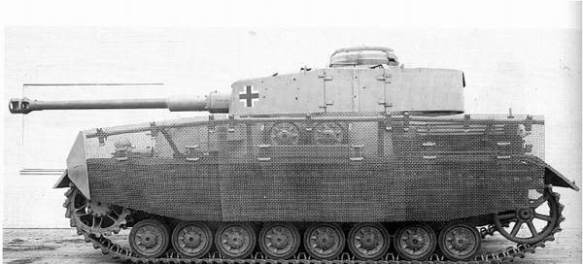In September 1944 Drahtgeflecht Schürzen (wire mesh) began replacing the steel plate Schürzen (on Panzer IV’s) starting in Sept-1944. The wire mesh was supported by steel strips at the top, which fastened or hooked to a metal pole which ran the length of the panzer. The pole ran parallel to the fenders and was positioned beyond them by brackets attached to the superstructure. Initially protection against Soviet anti-tank rifles it may have helped against heat projectiles. Most of the pictures I have seen show the Drahtgeflecht Schürzen mounted exclusively on StuG III G and PzKpfw IV tanks hulls (the turrets retained the steel plates) and sometimes Panzerjäger IVs. Thoma-Schürzen have given way to a variety of slat armor types. While slat armor might seem to be directly equivalent to Schürzen, today’s slat armor defeats modern RPGs by a fundamentally different process that exploits issues with the piezoelectric fuzes of modern RPGs – a technology not found on the World War II bazooka or Panzerfaust warhead.
BAZOOKA vs. PANZER Battle of the Bulge 1944
BAR armor positioned around an American Stryker 8×8 APC
RPG-7 warhead shown in cross-section with bar armor, illustrating how contact between the bars and the warhead will either damage the fuse electronics or the copper liner.
BAR armor, also commonly known as SLAT armor, cage armor and standoff armor, is designed to protect armored vehicles against attack by rocket-propelled grenades (RPGs). Bar armor is configured as a rigid metallic cage consisting of horizontally aligned plates contained within a structural framework that is positioned over the armored vehicles primary armor and stands off from the main hull. The armor can be configured to be placed around sensitive areas of the vehicle or to provide full vehicle coverage. The system functions by disrupting the RPG warhead through either damaging the copper liner or the fuse mechanism by short circuiting the piezoelectric precursor, disrupting formation of an effective jet.
Bar armor was inspired from the German Thoma-Schürzen during WWII and has been used on many AFVs since. Recent vehicles that have used bar armor include the Israel Defense Forces (IDF) Caterpillar D9R armored bulldozer, the Force Protection Buffalo MPV MRAP vehicle, the General Dynamics Stryker, the Ukrainian BTR-4, the Warrior Infantry Fighting Vehicle, the M113 APC, the British Challenger 2, the Leopard 2A6 main battle tank and Russian T-62 tanks. Slat armor is also part of the M1 Abrams TUSK urban warfare upgrade.
The armor is designed to defeat an incoming RPG round by having the bars contact and crush the warheads outer casing. The edges of the RPG are damaged through contact with the bars, often destroying the fuze electronics and electrical path to the detonator. Spacing between the slat plates is critical for disrupting the RPG warhead. If the spacing is too large, the warhead can slip between the slats. When the diameter of the warhead exceeds the spacing of the bar armor slats however the shell of the warhead will still be heavily damaged. Therefore most bar armor is designed to defeat RPG warheads with a small diameter, remaining effective against larger rounds without resulting in a higher overall armor weight.
As the Soviet RPG-7 rocket propelled grenade is the most commonly encountered threat, many bar armor systems are configured with a bar spacing optimized to defeat this threat. A wide variety of warheads are available for the RPG-7, ranging in diameter from 40 to 105 mm. These can weigh from 4 to 10 pounds. Tandem warheads have also been developed for defeating explosively reactive armor (ERA). Warhead penetration for RPG-7 warheads is generally considered to be between 11 inches to 24 inches (280-600 millimetres) RHA-e, depending on the specifics of the warhead configuration. Thus bar armor is an inexpensive and relatively low weight system to protect against a significant class of threats.
Bar armor is considered a “statistical armor” in that is reduces the probability of defeat of armor penetration, rather than providing ensured protection. The system is considered to successfully defeat approximately 50% of RPG rounds. Bar armor is preferred for many application due to its relatively low weight and cost compared to other systems used to protect against RPGs such as ERA. System weights of steel based bar armor are in the 40-60 pounds per square yard range, though even lighter composite and aluminum styles have been developed. In 2007 BAE (British Aerospace Engineering) Systems developed a lightweight aluminum slat armor system referred to as LROD. The system was claimed to weigh half of that of the corresponding steel solution. LROD was used on the Buffalo MPV and then was developed to fit onto the RG-33 vehicle.
